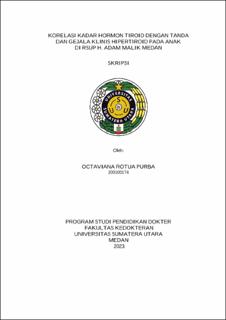| dc.description.abstract | Background: Hyperthyroidism is an endocrine disorder characterized by abnormal increases in the synthesis and secretion of thyroid hormones. Clinical manifestations of hyperthyroidism in children and adolescents are sometimes challenging to recognize compared to symptoms in adults. Decreased TSH levels and increased levels of fT4 and TRAb hormones may be associated with the emerging clinical symptoms. To date, there is limited research explaining the correlation between thyroid hormone levels and the signs and symptoms of hyperthyroidism in children, potentially leading to bias for clinicians in making an accurate diagnosis for patients. Objective: To determine the correlation between thyroid hormone levels and the clinical signs and symptoms of hyperthyroidism in children at H. Adam Malik General Hospital, Medan. Method: This study is an analytical study with a retrospective observational research design, with a total sample of 34 individuals. Statistical analysis in this study used the Pearson and Spearman correlation test with a significance level of p<0.05. Results and Discussion: The average age of children with hyperthyroidism in this study was 13 years, with females being the most common gender (88.2%). The majority of children with hyperthyroidism had a good nutritional status based on body mass index (85.3%). The most common clinical signs and symptoms were goiter and palpitations (67.6%), with Diffuse Struma being the most prevalent ultrasound appearance (70.9%). The average TSH level was 0.01 mIU/L, and fT4 was 2.71 ng/dL. A high percentage of children had a positive TRAb (94.1%). Negative correlation was found between TSH levels and clinical signs and symptoms of hyperthyroidism (p= 0.038, r= -0.361), while positive correlations were observed between fT4 levels and clinical signs and symptoms (p= 0.010, r= 0.440), as well as TRAb levels (p= 0.035, r= 0.381). Conclusion: There is a negative correlation between TSH levels and the clinical signs and symptoms of hyperthyroidism, and a positive correlation between fT4 and TRAb levels with the clinical signs and symptoms of hyperthyroidism in children. | en_US |


